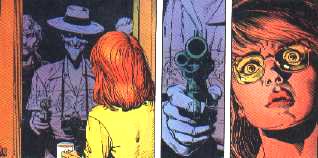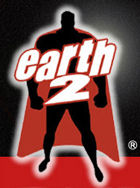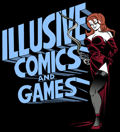|
One For
The Ages:
Barbara
Gordon and the (Il)Logic of Comic Book Age-Dating
A.
David Lewis, whom we profiled a few weeks ago, has been
lecturing and writing on comic book scholarship for quite
some time. As a result of our doing a story on him, he offered
this piece to Once
Upon A Dime.com. I'm publishing the introduction here,
so as to whet your appetite for the complete thing on Donald
Swan's website.
 |
When undertaking
the question of the comic book Ages, one could look no further
than a character from that selfsame medium, Barbara Gordon,
as a guide. Best known as DC Comics' Batgirl, Barbara Gordon
provides a useful entry point into the discussion of comic
book classification and dating nomenclature. The heroine long
ago hung up her chiropteran tights out of necessity: a gunshot
would to the spine left the librarian-by-day/vigilante-by-night
permanently paralyzed from the waist down. Moving from the
physical to the cerebral, the paraplegic turned handicap into
opportunity and reinvented herself as Oracle, remote "freelance
information broker who specializes in metahuman activities"
and "the JLA's secret member" (Morrison, 1998: 1,
75).
In this
role, she essentially acts as one of the superteam's most
"analytical thinkers" and information sources (Morrison,
1998: 123). Credited as being "a genius-level intellect
with a near-eidetic memory and a master in her field"
(Howze, 2003) as well as Wizard magazine's Greatest
Super-Heroine of All Time, Barbara is, to one way of thinking,
both the superhero most emblematic of and the icon most flattering
to the comic book scholar.
With Barbara
in mind as a muse, start with a crucial scene from her history,
that of her crippling in Alan Moore and Brian Bolland's Batman:
The Killing Joke. She is at home with her father, Gotham
City's Police Commissioner Jim Gordon, as he clips the latest
Joker article for his scrapbook. This scene follows pages
in which Batman occupies his lair, studying the little concrete
information he himself has on the Joker. In both the case
of the scrapbook and the Batcave database, classic, Golden
Age images of both Batman and the Joker appear, though the
savvy reader knows that these versions have been overwritten
by subsequent decades of creative teams and retroactive continuity
(retcon). With his sloppy pasteboard system, the Commissioner
is unbothered by this, mainly because he doesn't focus highly
on precise dating: "Look at this one. First time they
met. Now when was that?" (Moore, 1988: 12). Barbara,
on the other hand, has an altogether different approach: "Some
day you ought to let me work out a proper filing system, like
we used at the library" (Moore, 1988: 12).
 In
his book How to Read Superhero Comics and Why, Geoff Klock
notes this moment, saying: In
his book How to Read Superhero Comics and Why, Geoff Klock
notes this moment, saying:
Such
a system [as suggested by Barbara], however, would be impossible
when a contemporaneous article was authored by another character
practically written out of continuity, Vicky Vale. History
flows through the whole of The Killing Joke, but particularly
in this scene of Gordon's book keeping. Most revealingly we
are given a moment that reflects on the pastiche quality of
Bolland's art […] Barbara remarks, "Urrgh. Look,
you used too much paste! It's all squidging under the edges
of the clipping," exposing the artifice of the pastiche
and emphasizing the difficulty of making the pieces fit together
nicely. And Gordon literally tries to fit Batman's history
into a whole (2002: 59-60).
Klock
further argues, though, that a character's reaction to this
discombobulated history is what helps to define them. "Batman's
response is to organize the chaos, the Joker's to embrace
it, but Commissioner Gordon simply cannot remember" (2002:
60). Barbara, similar to her mentor Batman, wants to remember
and wants to organize Bolland's pastiche. Most of all, though,
she simply wants to have a logic to the system by which history
is dated. And, in that general manner, one should follow Barbara
Gordon.
Some,
though, would argue against wrangling with the Gordian (or
Gordanic) knot of chronological comic book classifications
- The Ages. Some, akin to the Commissioner, would rather not
be bothered with scrutinizing where one age or stage of the
genre ended and the next one began.
In his
1997 article for Comic Book Marketplace, Lou Mougin highlights
the arbitrariness of such labels. First, "it can be argued
that all these 'Ages' apply to superhero comics only"
(1997: 71). But, instead of being begrudging about this limitation,
it is more useful to whole-heartedly embrace it; it is an
acceptable, even welcomed, limitation to this corpus, giving
it a manageable shape.
Still,
there is the subjectivity of determining what is and is not
a 'superhero comic'; there is also the imposed back-dating
of the Ages with which to contend. "You can really only
identify the Ages that are clearly over," says writer
Kurt Busiek (Lewis, 2002). "So, the one you're in at
the moment is always called 'The Modern Age' until you give
it an actual name - because then you've put a headstone one
it and you're on to the next one" (Lewis, 2002).
So, not
only is the content of an Age determined by outside forces,
but also its span. This constructedness leaves Mougin to ask,
"Were there really Platinum, Golden, Silver, Bronze,
and Whatever Ages?" (Mougin, 1997: 71). In the end, he
is basically resigned to the frustrating group consensus that
"now we have four 'metal' Ages (Iron/Platinum, Gold,
Silver, and Bronze)…and it's only a matter of time, an
age, really, before somebody gives us another age" (Mougin,
1997: 71), even if there is no mass agreement to those headers
and no driving rationale behind their creation. This sort
of haphazard, slipshod arrangement barely qualifies as organization
- continuing Klock's Batman analogy, Mougin sees the Ages
as more Joker-esque, operating in a world either without logic
or with a twisted one, than like the Commissioner or Barbara
or even the Dark Knight himself.
All this
subjectivity doesn't invalidate the Age-dating system; quite
the contrary, it invites any number of outside interpreters
to make sense of its content. And plenty have. So, before
adding this article to their ranks, it seems advisable to
sketch out both parameters of the discussion, a sampling of
the various theories that have been set forth, and then propose
a new, potential classifications.
Therefore,
this dialogue will start at a point with the most logic, agreement,
and tradition: The Golden Age. Some sources, including The
Overstreet Comic Book Price Guide, consider there to be
a Platinum Age, which predates the Golden Age. However, few
if any, superhero titles populate this era; in fact none of
Overstreet's "Top 10 Platinum Books" resemble anything
that would be considered from the superhero genre (1999: 70).
For
the full article, follow
this link!
|

 In
his book How to Read Superhero Comics and Why, Geoff Klock
notes this moment, saying:
In
his book How to Read Superhero Comics and Why, Geoff Klock
notes this moment, saying:





